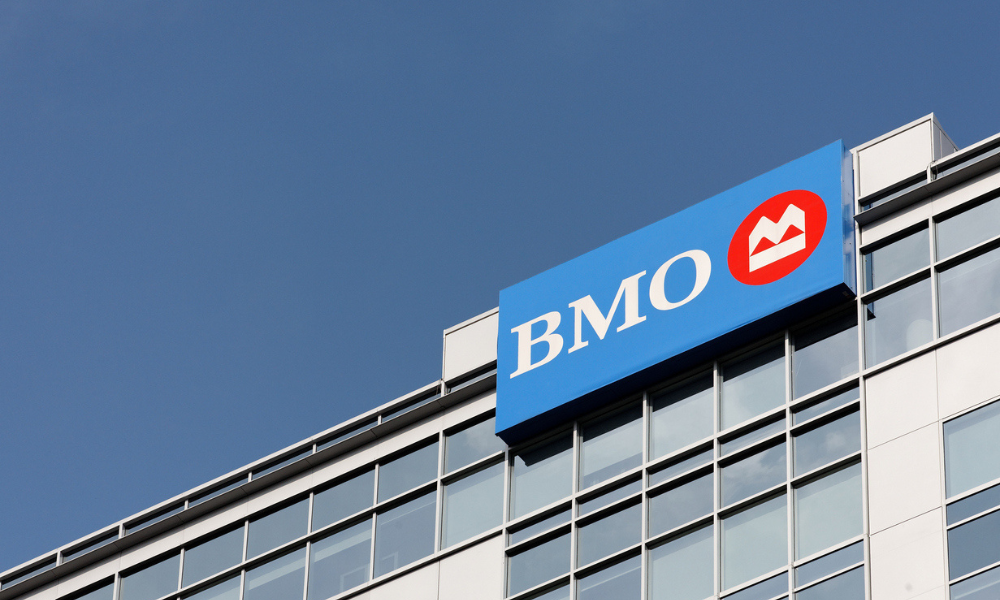Should your clients invest in BMO bank stocks? Aside from the Bank of Montreal’s standing and track record, what other factors should investors look at? We’ll go over that and more in this article

Many savvy advisors and investors will say that bank stocks are a good investment. This is due to their stability, ability to hold their value for the long term, and in some cases, their ability to provide dividends.
One bank stock of interest is Bank of Montreal (BMO) stock. As one of the Big Five banks of Canada, Bank of Montreal has a firm hold on its ranking in terms of capitalization. BMO has 13 million clients all over the world, with 8 million in Canada alone.
The Bank of Montreal employs more than 55,000 people and has a network consisting of 3,300 ATMs in Canada. In the J.D. Power 2023 Canada Retail Banking Satisfaction Study, BMO ranked number 1.
BMO was established in 1817 and is the oldest among Canada’s Big Five Banks.
all this raises several questions for investors:
-
is BMO bank stock a good buy?
-
is it of real value to investors?
-
what is the BMO bank stock forecast?
In this article, Wealth Professional seeks to provide insight into these and more.
Indicators of a good bank stock
When deciding on whether to buy bank stock, particularly BMO bank stock, it’s standard practice to look at their key indicators. The Ontario Securities Commission recommends that investors look at these indicators:
Market capitalization
market cap = total outstanding shares x stock price
This is a company’s total value of shares of stock. The market capitalization, aka market cap, is a relevant stock indicator because it can show investors the overall performance of the company, relative to its industry and industry rivals.
Price-to-book value (P/B) ratio
P/B ratio = company’s stock price per share ÷ book value per share
This ratio is an indicator of the company’s market cap compared to its book value. As much as possible, a stock should have a low P/B ratio, as this indicates that investors will pay less for a stock that has more book value.
Price-to-earnings (P/E) ratio
P/E ratio = current price per share ÷ earnings per share
The P/E ratio is a measure of a company’s stock price relative to its earnings per share (EPS). The P/E ratio can tell investors if a company’s stock price is high or low for its earnings.
Dividend yield
dividend yield = annual dividend per share ÷ price per share
This value shows how much a company pays out in dividends every year relative to its stock price. The result is the amount that the stocks pay out on every dollar invested in the stock.
Dividend payout ratio (DPR)
DPR = annual dividends per share ÷ earnings per share
This ratio shows how much of a company’s earnings are paid out to investors as dividends. The DPR is an important metric especially for dividend-paying stocks, as this is an indicator of how well a company’s earnings can support its dividend payments.
Is BMO a good stock to invest in?
To determine whether BMO bank stock is a viable investment, here’s how their stock indicators are faring as of this writing:
BMO Market Cap
|
Year |
Market Cap (in billions) |
% Change |
|---|---|---|
|
2024 |
$68.32 |
-4.38% |
|
2023 |
$71.45 |
12.14% |
|
2022 |
$63.71 |
-7.98% |
|
2021 |
$69.24 |
41.11% |
|
2020 |
$49.07 |
-0.36% |
For its market capitalization, Bank of Montreal has gone through a series of ups and downs expected of a bank stock. In the past five years or so, its market cap may have dipped slightly, but it has made up for the decline with significant spikes.
BMO appears to have a solid history of good earnings, with its market cap bouncing back significantly from small declines, but steadily increasing.
Bank of Montreal Stock (TSX:BMO)
|
Market Capitalization |
$68.32 billion |
|---|---|
|
P/B Ratio |
1.25 |
|
P/E Ratio |
12.8% |
|
DPR |
53.77% |
|
Dividend Yield |
4.66% |
As of May 2024, BMO bank stocks price is at $129.63 per share.
P/B Ratio
Ideally, a good stock would have its P/B ratio as equivalent to a value of 1 or lower. But since BMO’s P/B ratio is slightly above the industry average of 1, this means that the stock is selling a small amount higher than investors might like. But this is only one of a few other key indicators, so this shouldn’t form the sole basis for your investment decisions.
P/E Ratio
The average P/E ratio hovers around the 20 to 25 range. Any value below that range is indicative of a good price-to-earnings ratio. So, with Bank of Montreal’s P/E ratio at 12.8%, its stock has an excellent P/E ratio.
Dividend yield
Although a range of 2% to 6% is good, any dividend yield above 5% should be checked for its sustainability. In the case of Bank of Montreal, its current dividend yield is at 4.66%.
As this yield is still well below 5%, investors don’t have to worry about its sustainability. This is a better-than-average yield and is well-covered by the bank’s earnings.
Dividend payout ratio (DPR)
A good dividend payout ratio should range between 35% to 55%. A lower DPR than that would be both safe and sustainable. Bank of Montreal's DPR is at a reasonably good level of 53.77%.
A DPR within the average range means that the company has enough profits to reinvest in its growth and make it resilient enough to weather economic downturns.
Along with these key indicators, investors should keep a watchful eye on industry news. Recently, there was some bad news about BMO. Its stock had earnings that were a lot less than its earnings estimate and what was projected compared to the previous years. BMO bank stock had a net income of $1.29 billion, and an adjusted net income of $1.89 billion. Neither of the figures matched analysts' estimates.
BMO’s acquisition of Bank of the West in February 2023 was welcome news, giving its stock some net income. The deal is the largest acquisition in Canadian banking history and is expected to add almost 1.8 million customers into BMO’s fold. Investors can likely look forward to a good BMO earnings forecast in the coming months.
Bank of Montreal stock viability
Based on the numbers we’ve seen, is BMO bank stock a viable investment? The answer isn’t so clear-cut.
There are many other factors apart from the stock’s key metrics for it to be considered a viable investment. But with the information about the stock we have on hand, we can have a quick overview of BMO bank stock and provide some insight:
|
Bank of Montreal stock (TSX: BMO) performance as of late May 2024 |
|||
|---|---|---|---|
|
Metric |
Bank of Montreal |
Industry Average |
Verdict |
|
P/B Ratio |
1.25 |
>1, undervalued; <1, overvalued |
Slightly overvalued |
|
P/E Ratio |
12.8% |
20-25% |
Excellent |
|
DPR |
53.77% |
35-55% |
Acceptable |
|
Dividend Yield |
4.66% |
2-6% |
Acceptable |
A quick glance at BMO bank stocks shows that it may be an average-performing stock, since its mildly high P/B ratio makes it a bit overvalued. Advisors with clients who have a moderate to conservative risk appetite, more wiggle room in their budget and a longer time horizon may want to buy shares.
Advisors should consider their clients’ personal circumstances and factors like:
-
risk appetite
-
preferred investment approach
-
time horizon
-
financial goals
While BMO bank stocks appear to be viable, investors may want to hold off on buying. At least not until they’ve looked over the best Canadian bank stocks to invest in.
But what if your clients already have BMO bank stock? What should they do with their investment? Should they buy more, sell what they have, or hold onto them?
Opinions on what to do with BMO bank stock appear to be mixed, with some analysts recommending buying more of the stock and others advising investors to hold, giving it a low sell rating. Analysts say that Bank of Montreal has a lot of exposure to commercial banking, making it a recessionary risk. RBC, TD, and National Bank of Canada stock might be better alternatives.
Is BMO bank stock right for your clients?
While it is true that the other Big Five banks may be better investments, BMO bank stock should not be discounted. It can still provide good portfolio diversification, and it offers a relatively high and sustainable dividend yield of 4.66%. Clients who want a more liquid investment may be pleased with this stock.
Here’s a video from Morningstar that touts some great features of BMO bank stocks. First, its limited exposure to the real estate market shields it from any adverse events affecting local housing. Second, BMO’s acquisition of Bank of the West diversifies its investments. How much more business does this translate to for BMO? Watch until the end of the video – what you hear might make you decide on investing in BMO bank stock:
Another attractive draw of BMO bank is its ethical practices. It’s been named one of the world’s most ethical companies – the only Canadian bank on the list – for the seventh straight year. Clients who put a premium on ESG investing will surely find BMO bank stock an appealing addition to their portfolio.
For more investment strategies for BMO and other bank stocks, visit our Best in Wealth section. Get sound advice from the best and the brightest in Canada’s financial industry.



